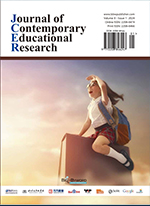A Study on the Correlation Between LIWC Word Categories and Chinese Composition Writing Performance of Fourth, Fifth, and Sixth Grade Students
Abstract
This study focuses on the analysis of the Chinese composition writing performance of fourth, fifth, and sixth grade students in 16 selected schools in Longhua District, Shenzhen during the spring semester of 2023. Using LIWC (Linguistic Inquiry and Word Count) as a text analysis tool, the study explores the impact of LIWC categories on writing performance which is scaled by score. The results show that the simple LIWC word categories have a significant positive influence on the composition scores of lower-grade students; while complex LIWC word categories have a significant negative influence on the composition scores of lower-grade students but a significant positive influence on the composition scores of higher-grade students. Process word categories have a positive influence on the composition scores of all three grades, but the impact of complex process word categories increases as the grade level rises.
References
Li H, Liu R, 2013, The Relationship Between Foreign Language Writing Anxiety and Writing Self-Efficacy of College Students and Its Prediction on Writing Achievement. Foreign Language Research, 2(7): 48–54.
Dai J, Xu S, 2001, A Study on the Allocation of Pre-Composition Thinking Time and its Influence on Writing Achievement. Psychological Development and Education, 17(2): 36–40.
Duan W, Year, A Study on the Correlation Between High School Students’ English Writing Strategies and Writing Achievement, dissertation, Minnan Normal University, 2016.
Li W, Li F, 2003, An Experimental Study on the Effects of Goal Orientation and Progress Feedback on Writing Achievement of Top and Bottom Students. Psychological Science, 26(6): 1086–1090.
Xiao W, 2011, An Empirical Study on the Improvement of Students’ English Writing Proficiency by Metacognitive Strategy Training. Journal of Foreign Languages, 27(5): 124–127.
Zhao C, 2020, Application Strategies of Information Technology in Middle School Mathematics Teaching Classroom. Literature Youth, 2020(020): 1.
Zhu W, 2017, The Application of Situational Teaching in Junior Middle School Chinese Writing Teaching. Urban Tutoring: The Second Half of the Month, 2017(6): 51.
Duan X, 2014, Reflection on Chinese Writing Teaching in Senior High Schools. Reading and Writing: Journal of Education and Teaching, 11(11): 1.
Li M, Li W, Bei W, 2021, A Study on the Correlation Between Chinese Writing Attitude and Writing Achievement of High School Students. Teaching Reference for Middle Schools, 2021(24): 3.
Wang L, 2008, A Study on the Correlation Between Second Language Writing Anxiety and Native Language Writing Ability. Journal of Gansu Normal University, 13(3): 3.
Tausczik YR, Pennebaker JW, 2010, The Psychological Meaning of Words: LIWC and Computerized Text Analysis Methods. Journal of Language and Social Psychology, 29(1): 24–54.
Kahn JH, Tobin RM, Massey AE, et al., 2007, Measuring Emotional Expression with the Linguistic Inquiry and Word Count. The American Journal of Psychology, 120(2): 263–286.
Yu G, 2010, Lexical Diversity in Writing and Speaking Task Performances. Applied Linguistics, 31(2): 236–259.
Lumontod III RZ, 2020, Seeing the Invisible: Extracting Signs of Depression and Suicidal Ideation from College Students’ Writing Using LIWC a Computerized Text Analysis. Int. J. Res. Stud. Educ, 2020(9): 31–44.
Chandler S, 2007, Fear, Teaching Composition, and Students’ Discursive Choices: Re-Thinking Connections Between Emotions and College Student Writing. Composition Studies, 35(2): 53–70.
Shao KQ, Yu WH, Ji ZM, 2013, The Relationship Between EFL Students’ Emotional Intelligence and Writing Achievement. Innovation in Language Learning & Teaching, 7(2): 107–124.

